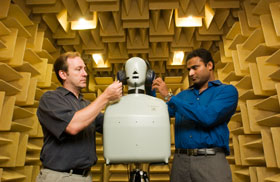Headlines
As reported by the New Haven Register, January 8, 2006.
UConn Health Center to Develop Noise-reducing Headsets
By Abram Katz

Donald Peterson, left, director of the Biodynamics Laboratory at the University of Connecticut Health Center, and Subhash Gullapalli, a research engineer, set up a dummy in an anechoic, or no reverberation, chamber at the health center.
Missing a turn because you couldn’t hear directions amid the din of a car full of teenagers is usually not a problem.
Missing a turn and rolling onto the wrong runway in an airliner because the pilot cannot hear the control tower is a potential catastrophe — and it happens with frightening frequency.
NASA has awarded $2.5 million to the Biodynamics Laboratory at the University of Connecticut Health Center to develop technology to dampen extraneous cockpit noise and improve communication between air traffic controllers and the jets that they juggle.
Pilots are bathed in background noise from turbofans, control surfaces like flaps, wind and the crew. At the same time, the pilot must monitor ground-to-air radio messages, which can be degraded by electronic interference.
"Basically, this is research on voice communication. There are a lot of misunderstood call signs and directions in airplanes," said Donald R. Peterson, director of the Biodynamics Laboratory.
"Runway incursions" and other surface incidents are a growing threat, he said. The number of near mid-air collisions remained constant during the last five years, while jets taxiing through busy runways and tarmacs based on mistaken information is increasing.
Some of the problem is related to the speed at which information must be sent and received, Peterson said. Neither pilots nor controllers can spend several minutes reviewing instructions.
The result is the clipped airspeak that passengers can sometimes hear through headphones. Only a couple of syllables of "TWA 120 proceed to gate one-nine" need to be garbled for the worst to happen.
So Peterson and colleagues are developing a headphone device to filter out unwanted noise and increase intelligibility. Their first focus will be helpful electronics for ground controllers. Devices for pilots are also a priority.
A variety of consumer products purport to use active noise cancellation, but what Peterson has in mind is far more powerful and precise.
"Initially, we’re looking at headsets. We can put in active or passive noise control systems," Peterson said.
Passive measures, such as earplugs, prevent a percentage of sound waves from reaching the ear. This is useful in helicopters and tanks, which present copious external noise.
Active control is more complicated but can isolate desired components from a sea of waves. Current systems employ computers that monitor sound before it reaches ears. The circuit then creates corresponding anti-noise. When a wave crest meets a trough of equal intensity, the result is no wave and no sound.
The Biodynamics Laboratory is concentrating on systems designed to work with English. Most pilots and controllers speak English. Also, some languages, such as Dutch and German, are more difficult to cancel.
Instead of trying to get all of the English through the noise, the lab is concentrating on certain vocal frequencies. Human ears can detect sounds from a high-pitched 20 kilohertz down to a low 80 hertz.
Higher frequencies are crucial to hearing and understanding, Peterson said.
The actual anti-noise device must pack a power source and all of the electronics into a micro-miniature package that fits comfortably in a head set.
The Biodynamics lab has two special rooms. One is lined with sound-absorbing material and is anechoic, meaning there is no reverberation. This allows scientists to analyze acoustic noise and see how people and animals respond to sound and vibration.
Next door is an echo chamber that can produce noise up to 120 decibels, which is in the range of a race car or a jet taking off. This chamber is used with an electronic ear to see how well signals get through noise-reduction devices.
Peterson is interested in more than pilot and controller headsets.
The anechoic chamber is useful in testing tools to see which parts are vibrating and producing noises. Sound, after all, is waves of compressed air launched by a vibrating object — a vocal cord, electrical speaker, a guitar string or dozens of parts of a jet engine.
To test a loud industrial grinder, lab workers mounted a grid of microphones around the thunderous machine. The microphones pick up the parts that are vibrating most.
Vibration can be dampened by adding mass to lower the frequency out of human range or by isolating the component, Peterson said. Putting the rubber of plastic blocks between the culprit and the rest of the equipment is usually the best approach.
Acoustic research has many potential applications, which is why NASA is pursuing noise cancellation technology.
Research on quieting jet engines from the inside is continuing with active components to counteract the multitude of sounds generated by compressor blades, turbine blades, stators, and combustion.
Ultimately, noise reduction devices could be useful in fire trucks and emergency vehicles, construction equipment, manufacturing, oil drilling and has many military applications.
In all of these cases, the main goal is to facilitate clearer voice communication, so that fluttering vocal cords are not overcome by throbbing, pulsing machines.


